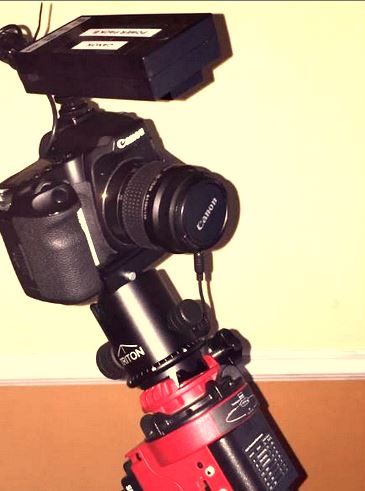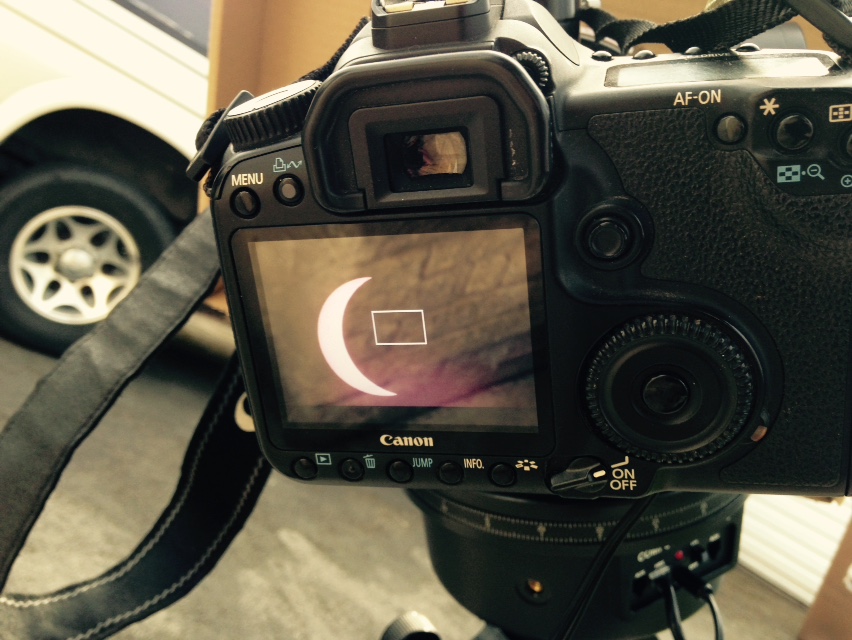The Crab Nebula from California - 30th September 2016
 Saturday, October 1, 2016 at 8:19AM
Saturday, October 1, 2016 at 8:19AM  M1 from T24 California 600second exposure
M1 from T24 California 600second exposure
 [Your Name Here] | Comments Off |
[Your Name Here] | Comments Off |
Ford's excellent
monthly calendar
ABOUT THE WEBSITE - CLICK HERE
My Telescopes
My Main Telescope - C14 and Paramount ME

My new Paramount MyT and 8-inch Ritchey-Chretien Telescope

MyT Hand Controller
My Meade 12 inch SCT on a CGEM (Classic) Mount
My 4 inch Meade Refractor with Sky Watcher Guidescope and ZWO camera on a CGEM (Classic) Mount

Skywatcher Star Adventurer Mount with Canon 40D
My Solar setup using a DSLR and Mylar Filter on my ETX90

DSLR attached to ETX90. LiveView image of 2015 partial eclipse on Canon 40D
I try to log my observing and related activities in a regular blog - sometimes there will be a delay but I usually catch up. An index of all my blogs is on the main menu at the top of the page with daily, weekly or monthly views. My Twitter feed is below. I am also interested in photograping wildlife when I can and there is a menu option above to look at some of my images. I try to keep the news feeds from relevant astronomical sources up to date and you will need to scroll down to find these.
The Celestron 14 is mounted on a Paramount ME that I have been using for about 10 years now - you can see that it is mounted on a tripod so is a portable set up. I still manage to transport it on my own and set it all up even though I have just turned 70! It will run for hours centering galaxies in the 12 minute field even when tripod mounted.
 Saturday, October 1, 2016 at 8:19AM
Saturday, October 1, 2016 at 8:19AM  M1 from T24 California 600second exposure
M1 from T24 California 600second exposure
 Monday, September 26, 2016 at 8:20AM
Monday, September 26, 2016 at 8:20AM I took this image of M29 remotely from Spain last night
T07-lenadam-M29-20160925-223826-Luminance-BIN1-W-300-001.fit (300 seconds)
This is the low res preview image.
From Wikipedia about M29:
"Messier 29 (also known as M 29 or NGC 6913) is an open cluster in the Cygnus constellation. It was discovered by Charles Messier in 1764, and can be seen from Earth by using binoculars.
The star cluster is situated in the highly crowded area of Milky Way near Gamma Cygni, at a distance of 7,200 (most sources including Mallas/Kreimer and Burnham, and agreeing with early estimates or R.J. Trumpler 1930) or 4,000 light years (the latter from Kenneth Glyn Jones and the Sky Catalogue 2000.0). The Night Sky Observer's Guide by Kepple and Sanner gives a deviating value of 6,000 light years – the uncertainty due to inaccurately known absorption of the cluster's light.
According to the Sky Catalog 2000, M29 is included in the Cygnus OB1 association, and approaching us at 28 km/s. Its age is estimated at 10 million years, as its five hottest stars are all giants of spectral class B0. The Night Sky Observer's Guide gives the apparent brightness of the brightest star as 8.59 visual magnitudes. The absolute magnitude may be an impressive -8.2 mag, or a luminosity of 160,000 Suns. The linear diameter was estimated at only 11 light years. Its Trumpler class is III,3,p,n (as it is associated with nebulosity), although Götz gives, differently, II,3,m, and Kepple/Sanner gives I,2,m,n. The Sky Catalogue 2000.0 lists it with 50 member stars; earlier Becvar gave only the number of 20 members.
This cluster can be seen in binoculars. In telescopes, lowest powers are best. The brightest stars of M29 form a "stubby dipper", as Mallas says it. The four brightest stars form a quadrilateral, and another three, a triangle north of them. It is often known as the "cooling tower" due to its resemblance to the hyperboloid-shaped structures. A few fainter stars are around them, but the cluster appears quite isolated, especially in smaller telescopes. In photographs, a large number of very faint Milky Way background stars shows up.
M29 can be found quite easily as it is about 1.7 degrees South and little East of Gamma or 37 Cygni (Sadr). In the vicinity of M29, there is some diffuse nebulosity which can be detected in photographs."
 Saturday, September 24, 2016 at 8:57AM
Saturday, September 24, 2016 at 8:57AM The Autumn edition of the SHA Bulletin is about to be delivered. Don't miss out on this issue which is now in full colour. https://societyforthehistoryofastronomy.com/

 Saturday, September 24, 2016 at 8:48AM
Saturday, September 24, 2016 at 8:48AM I used telescope T14 with a photometric V filter to take an image of M31. This is a snip of the low res preview image. I also took FITS and TIFF images yet to be processed. A 180 second exposure.

From Wikipedia about M31:
"
The Andromeda Galaxy (/ænˈdrɒmᵻdə/), also known as Messier 31, M31, or NGC 224, is a spiral galaxy approximately 780 kiloparsecs (2.5 million light-years) from Earth.[4] It is the nearest major galaxy to the Milky Way and was often referred to as the Great Andromeda Nebula in older texts. It received its name from the area of the sky in which it appears, the constellation of Andromeda, which was named after the mythological princess Andromeda.
Being approximately 220,000 light years across, Andromeda is the largest galaxy of the Local Group, which also contains the Milky Way, theTriangulum Galaxy, and about 44 other smaller galaxies. Despite earlier findings that suggested that the Milky Way contains more dark matterand could be the largest in the grouping,[12] the 2006 observations by the Spitzer Space Telescope revealed that Andromeda contains one trillion (1012) stars:[9] at least twice the number of stars in the Milky Way, which is estimated to be 200–400 billion.[13]
The mass of the Andromeda Galaxy is estimated to be 1.5×1012 solar masses,[7] while the Milky Way is estimated to be 8.5×1011 solar masses. In comparison, a 2009 study estimated that the Milky Way and M31 are about equal in mass,[14] while a 2006 study approximated the mass of the Milky Way at 80% of the mass of the Andromeda Galaxy. The Milky Way and Andromeda are expected to collide in 3.75 billion years, eventually merging to form a giant elliptical galaxy [15] or perhaps a large disc galaxy.[16] The apparent magnitude of the Andromeda Galaxy, at 3.4, is among the brightest of the Messier objects,[17] making it visible to the naked eye on moonless nights, even when viewed from areas with moderate light pollution."
 Saturday, September 24, 2016 at 7:32AM
Saturday, September 24, 2016 at 7:32AM I used the 6 inch refractor with a single shot colour camera to image M33 a moment ago.
T3-lenadam-M33-20160923-005027-Color-BIN1-E-300-001.fit (300 seconds)
This is the preview image.
 Sunday, April 10, 2016 at 10:34AM
Sunday, April 10, 2016 at 10:34AM Book 1: Herschel at the Cape - Diaries and Correspondence of Sir John Herschel 1834 - 1838
 Sunday, January 24, 2016 at 11:08AM
Sunday, January 24, 2016 at 11:08AM I was looking at images from my last time in Spain and this caught my eye. Taken with a modfied Canon 40D.

 Friday, January 22, 2016 at 1:10PM
Friday, January 22, 2016 at 1:10PM Comet 67P/Churyumov-Gerasimenko this morning. Remote image from New Mexico.